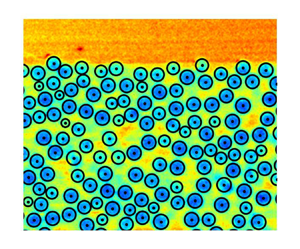Article contents
The characterization of the particle normal stresses of concentrated granular suspensions by local rheometry
Published online by Cambridge University Press: 21 July 2023
Abstract

The normal and shear viscosities of non-Brownian suspensions are measured by optical suspension imaging for particle volume fractions  $\phi$ between
$\phi$ between  $0.3\phi _m$ and
$0.3\phi _m$ and  $0.98\phi _m$, where
$0.98\phi _m$, where  $\phi _m$ is the jamming fraction. Two distinct refractive-index-matched suspensions, made with the same polymethyl methacrylate spherical particles dispersed in a mixture of water and Triton X-100, are studied. One is density-matched while the other one is negatively buoyant. They are both sheared in a Couette rheometer where the velocity and particle volume fraction fields are measured. The shear viscosity and the second particle normal stress
$\phi _m$ is the jamming fraction. Two distinct refractive-index-matched suspensions, made with the same polymethyl methacrylate spherical particles dispersed in a mixture of water and Triton X-100, are studied. One is density-matched while the other one is negatively buoyant. They are both sheared in a Couette rheometer where the velocity and particle volume fraction fields are measured. The shear viscosity and the second particle normal stress  $\varSigma _{22}^p$ are determined through the study of these profiles in the neutrally buoyant suspension, while the third particle normal stress
$\varSigma _{22}^p$ are determined through the study of these profiles in the neutrally buoyant suspension, while the third particle normal stress  $\varSigma _{33}^p$ is deduced from the analysis of the vertical
$\varSigma _{33}^p$ is deduced from the analysis of the vertical  $\phi$ profiles measured in the negatively buoyant suspension. Our results indicate that the shear viscosity decreases with shear stress
$\phi$ profiles measured in the negatively buoyant suspension. Our results indicate that the shear viscosity decreases with shear stress  $\varSigma _{12}$, and that this shear-thinning behaviour can be captured by the variation of
$\varSigma _{12}$, and that this shear-thinning behaviour can be captured by the variation of  $\phi _m$ with
$\phi _m$ with  $\varSigma _{12}$. We show that
$\varSigma _{12}$. We show that  $\varSigma _{33}^p$ is proportional to
$\varSigma _{33}^p$ is proportional to  $\varSigma _{12}$, and that
$\varSigma _{12}$, and that  $\varSigma _{33}^p/\eta _0\dot {\gamma }$ is a function of only
$\varSigma _{33}^p/\eta _0\dot {\gamma }$ is a function of only  $\phi /\phi _m(\varSigma _{12})$. The values of
$\phi /\phi _m(\varSigma _{12})$. The values of  $\varSigma _{22}^p$ deduced from the radial
$\varSigma _{22}^p$ deduced from the radial  $\phi$ profiles are consistent with the results of Zarraga et al. (J. Rheol., vol. 44, 2000, pp. 185–220). We conclude by discussing our results in the framework of the
$\phi$ profiles are consistent with the results of Zarraga et al. (J. Rheol., vol. 44, 2000, pp. 185–220). We conclude by discussing our results in the framework of the  $\mu (J)$ rheology for viscous numbers
$\mu (J)$ rheology for viscous numbers  $J$ ranging from
$J$ ranging from  $2\times 10^{-4}$ to
$2\times 10^{-4}$ to  $3\times 10^1$. We obtain very good agreement with the results obtained by Boyer et al. for
$3\times 10^1$. We obtain very good agreement with the results obtained by Boyer et al. for  $J\lesssim 10^{-1}$ (Phys. Rev. Lett., vol. 107, 2011, 188301) and by Zarraga et al. for
$J\lesssim 10^{-1}$ (Phys. Rev. Lett., vol. 107, 2011, 188301) and by Zarraga et al. for  $J\gtrsim 10^{-1}$.
$J\gtrsim 10^{-1}$.
Information
- Type
- JFM Papers
- Information
- Copyright
- © The Author(s), 2023. Published by Cambridge University Press
References
- 5
- Cited by


